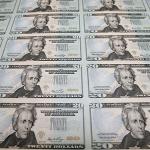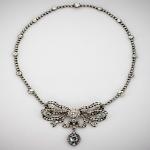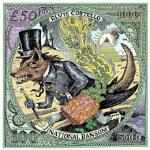2010-11-11

Photo: AP
Newly printed $20 bills, with the image of President Andrew Jackson, at the Bureau of Engraving and Printing in Washington
DOUG JOHNSON: Welcome to AMERICAN MOSAIC in VOA Special English.
(MUSIC)
I'm Doug Johnson.
This week, we play songs from two new albums from music greats Elton John and Leon Russell and Elvis Costello.
We also answer a question about the faces found on American money ...
But first, a report on a shiny gem new to the Smithsonian museum in Washington.
(MUSIC)
Cullinan Diamond
 Thomas Cullinan, owner of the Cullinan Premier mine in South Africa, gave the Cullinan Blue Diamond necklace to his wife
Thomas Cullinan, owner of the Cullinan Premier mine in South Africa, gave the Cullinan Blue Diamond necklace to his wifeDOUG JOHNSON: The Smithsonian National Museum of Natural History recently added a new gem to its collection. The Cullinan Diamond necklace is now on view at the museum with another famous jewel, the Hope Diamond.
Though smaller than the Hope Diamond, gemologists say the Cullinan Diamond is just as beautiful. Curator Jeffrey Post says it is one of the greatest gifts the museum has ever received. Katherine Cole has more.
KATHERINE COLE: The silver necklace has two hundred fifty-one diamonds. It has a beautiful bow and oval-shaped design in the center. Nine extremely rare blue diamonds are part of the design. The rare blue diamonds total more than five carats.
Like the Hope Diamond, the Cullinan Diamond also has a rich history. It is named after Thomas Cullinan, a famous South African explorer. He owned the Premier Diamond Mine in South Africa.
Mr. Cullinan had promised his wife that he would find her the largest diamond in the world. His workers found such a diamond in nineteen-oh-five. It weighed almost three thousand one hundred seven carats before it was cut and polished. At that time, it was the biggest diamond ever discovered.
Thomas Cullinan sold the uncut diamond to the Transvaal government. It was later given to British King Edward VII on his birthday. The diamond was then cut into a number of different jewels which became part of the British Royal Family collection. The most famous of the pieces is known as the Star of Africa.
Mr. Cullinan had the Cullinan Diamond Necklace created as a special present for his wife in nineteen ten. The necklace was passed down to the first daughter of each family until it was sold by a great-granddaughter in the early nineteen eighties.
Experts say the design of the Cullinan Diamond Necklace is an example of the jewelry of the Edwardian time period when the necklace was created.
The Cullinan Diamond Necklace is on view at the Harry Winston Gallery in the National History Museum. It is on a shiny blue cloth which helps bring out the beauty of its rare blue diamonds.
An unidentified person gave the necklace to the museum in honor of its one hundredth anniversary.
It will remain on view at the Harry Winston Gallery until next spring when it moves to its permanent home in the National Gem Gallery.
Men on the Money
DOUG JOHNSON:
Our listener question this week comes from Iraqi Kurdistan. Farman Salih wants to know about the men whose pictures are on American paper money and why they were important.
The picture of George Washington is on the one-dollar bill. He served as America's first president from seventeen eighty-nine to seventeen ninety-seven. President Washington has been called the "Father of his Country."
The third president of the United States, Thomas Jefferson, is on the two-dollar bill. He was the main writer of the Declaration of Independence in seventeen seventy-six. Jefferson was one of the most influential of the nation's Founding Fathers. He was also a plant expert, architect, musician and inventor.
Another of America's greatest presidents, Abraham Lincoln, is on the five-dollar bill. He served as the sixteenth president from eighteen sixty-one until eighteen sixty-five. He successfully led the country through the Civil War, saved the Union and ended slavery.
The picture of Alexander Hamilton appears on the ten-dollar bill. Hamilton was never president. But he was the first Secretary of the Treasury and one of the Founding Fathers. He was also an economist and political philosopher.
Andrew Jackson was the seventh president, serving from eighteen twenty-nine to eighteen thirty-seven. He supported popular democracy and individual liberty. His picture is on the twenty-dollar bill.
Another president is on the fifty-dollar bill. Ulysses S. Grant served from eighteen sixty-nine to eighteen seventy-seven. Before serving as president, Grant was the military commander of Union forces during the Civil War. Under his command, the Union Army defeated Confederate forces.
So who do you think is on the one hundred-dollar bill? It is Benjamin Franklin. Franklin was never elected president, but was one of the Founding Fathers. He was also a leading writer and printer, political thinker, politician, postmaster, scientist, inventor, civic activist and diplomat.
These American statesmen are on front of the one, two, five, ten, twenty, fifty and one hundred dollar bills. The backs of the notes show images from the nation's history or famous places. They are, in order, the Great Seal of the United States, the signing of the Declaration of Independence and the Lincoln Memorial. The others are the Treasury Building, the White House, the Capitol building and Independence Hall.
You can learn about how American money is made on the Special English program THIS IS AMERICA on Monday.
T-Bone Burnett
 Thomas Cullinan, owner of the Cullinan Premier mine in South Africa, gave his wife the Cullinan Blue Diamond necklace
Thomas Cullinan, owner of the Cullinan Premier mine in South Africa, gave his wife the Cullinan Blue Diamond necklaceDOUG JOHNSON: Musician T-Bone Burnett recently produced two albums. He worked with Elvis Costello, Elton John, Leon Russell and others. Mario Ritter plays some music and tells about the new records.
MARIO RITTER: This is not the first time T-Bone Burnett has worked with singer-songwriter Elvis Costello. They have produced several albums together. T-Bone Burnett has also written and performed on Costello's albums.
"National Ransom" is the latest. It is a double album. It has been released digitally and on CD but there is also a vinyl recording for sale. And Costello thinks this is the way it sounds best. He says digital may be easier to get. But he says listeners cheat themselves if they do not hear the vinyl version.
Here Elvis Costello performs "Jimmie Standing in the Rain" from "National Ransom."
(MUSIC)
T-Bone Burnett also produced the album "The Union." It features two singer-songwriters, Elton John and Leon Russell. Burnett says the record was made because Elton John considered Leon Russell a musical hero and had always wanted to work with him. Here they perform "Jimmie Rodgers Dream."
(MUSIC)
Last month, T-Bone Burnett got all three men and a few other artists he works with to perform live together. They held concerts in Boston and New York to raise money for arts and music education in public schools.
We leave you with Elton John and Leon Russell performing "Hearts Have Turned to Stone" from their new album "The Union."
(MUSIC)
DOUG JOHNSON: I'm Doug Johnson. Our program was written by June Simms, Shelley Gollust and Caty Weaver, who also was our producer.
You can get transcripts, MP3s and podcasts of our shows at 51voa.com. You can also find us on Facebook and Twitter at VOA Learning English.
If you have a question about American life, write to mosaic@voanews.com. Be sure to include your name and country.
Join us again next week for AMERICAN MOSAIC, VOA's radio magazine in Special English.